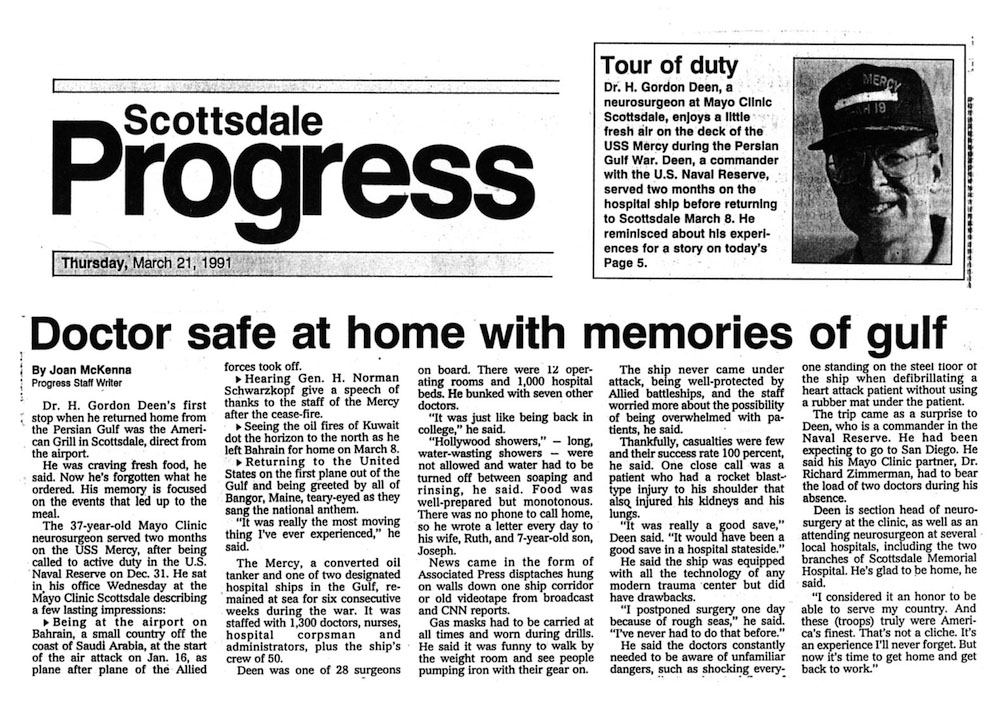Tour of Duty: Doctor Safe at Home with Memories of Gulf
Scottsdale Progess March 21, 1991Dr. H. Gordon Deen’s first stop when he returned home from the Persian Gulf was the American Grill in Scottsdale, direct from the airport.
He was craving fresh food, he said. Now he’s forgotten what he ordered. His memory is focused on the events that led up to the meal.

The 37-year-old Mayo Clinic neurosurgeon served two months on the USS Mercy, after being called to active duty in the U.S. Naval Reserve on Dec. 31. He sat in his office Wednesday at the Mayo Clinic Scottsdale describing a few lasting impressions:
— Being at the airport in Bahrain, a small country off the coast of Saudi Arabia, at the start of the air attack on Jan. 16, as plane after plane of the Allied forces took off.
— Hearing Gen. H. Norman Schwarzkopf give a speech of thanks to the staff of the Mercy after the cease-fire.
— Seeing the oil fires of Kuwait dot the horizon to the north as he left Bahrain for home on March 8.
— Returning to the United States on the first plane out of the Gulf and being greeted by all of Bangor, Maine, teary-eyed as they sang the national anthem.
“It was really the most moving thing I’ve ever experienced,” he said.
The Mercy, a converted oil tanker and one of two designated hospital ships in the Gulf, remained at sea for six consecutive weeks during the war. It was staffed with 1,300 doctors, nurses, hospital corpsman and administrators, plus the ship’s crew of 50.
Deen was one of 28 surgeons on board. There were 12 operating rooms and 1,000 hospital beds. He bunked with seven other doctors.
“It was just like being back in college,” he said.
“Hollywood showers” — long, water wasting showers — were not allowed and water had to be turned off between soaping and rinsing, he said. Food was well-prepared but monotonous. There was no phone to call home, so he wrote a letter every day to his wife, Ruth, and 7-year-old son, Joseph.
News came in the form of Associated Press dispatches hung on walls down one ship corridor or old videotape from broadcast and CNN reports.
Gas masks had to be carried at all times and worn during drills. He said it was funny to walk by the weight room and see people pumping iron with their gear on.
The ship never came under attack, being well-protected by Allied battleships, and the staff worried more about the possibility of being overwhelmed with patients, he said.
Thankfully, casualties were few and their success rate 100 percent, he said. One close call was a patient who had a rocket blast-type injury to his shoulder that also injured his kidneys and lungs.
“It was really a good save,” Deen said. “It would have been a good save in a hospital stateside.”
He said the ship was equipped with all the technology of any modern trauma center but did have drawbacks.
“I postponed surgery one day because of rough seas,” he said. “I’ve never had to do that before.”
He said the doctors constantly needed to be aware of unfamiliar dangers, such as shocking everyone standing on the steel floor of the ship when defibrillating a heart attack patient without using a rubber mat under the patient.
The trip came as a surprise to Deen, who is a commander in the Naval Reserve. He had been expecting to go to San Diego. He said his Mayo Clinic partner, Dr. Richard Zimmerman, had to bear the load of two doctors during his absence.
Deen is section head of neurosurgery at the clinic, as well as an attending neurosurgeon at several local hospitals, including the two branches of Scottsdale Memorial Hospital. He’s glad to be home, he said.
“I considered it an honor to be able to serve my country. And these (troops) truly were America’s finest. That’s not a cliche. It’s an experience I’ll never forget. But now it’s time to get home and get back to work.”